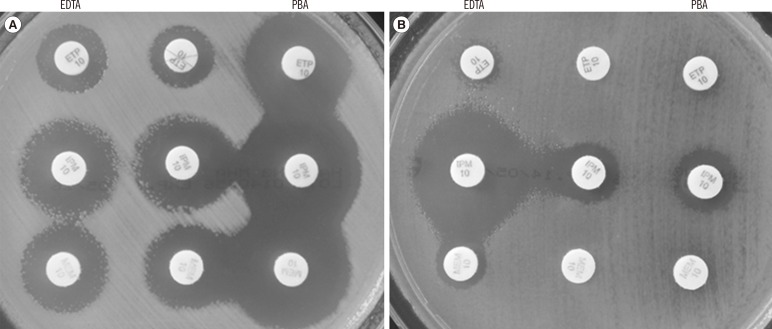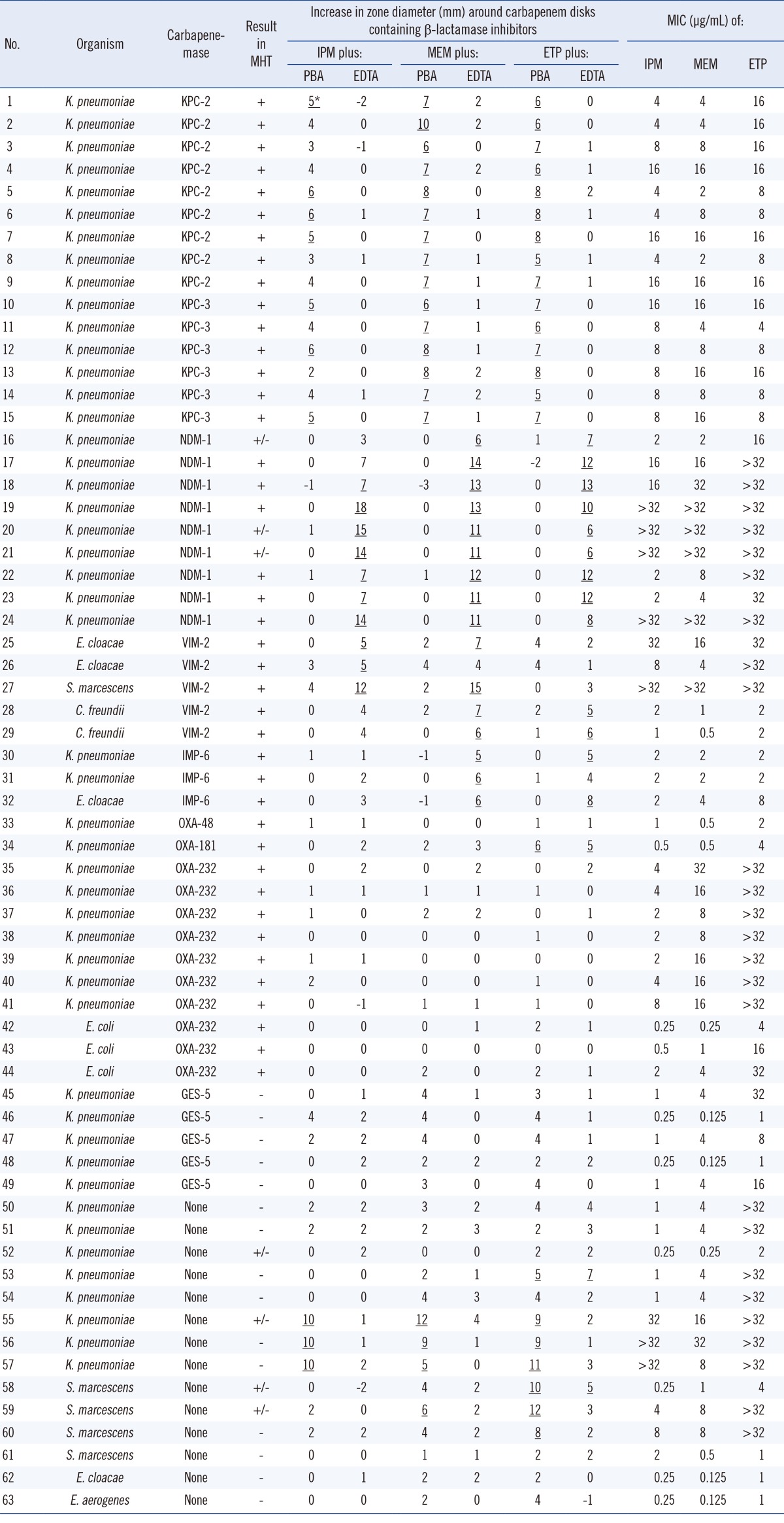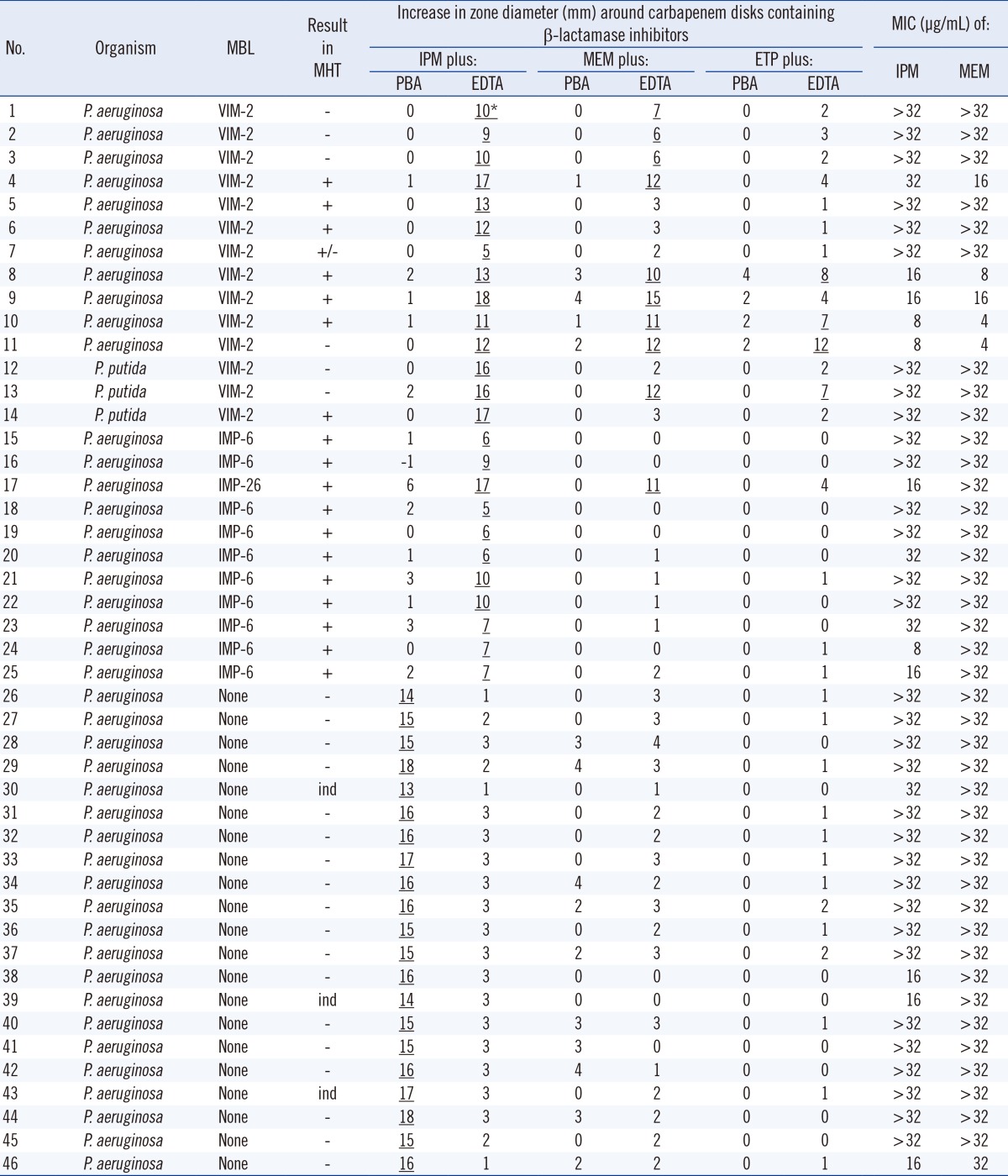1. Patel JB, Rasheed JK, Kitchel B. Carbapenemase in Enterobacteriaceae: activity, epidemiology, and laboratory detection. Clin Microbiol Newslett. 2009; 31:55–62.
2. Seah C, Low DE, Patel SN, Melano RG. Comparative evaluation of a chromogenic agar medium, the modified Hodge test, and a battery of meropenem-inhibitor discs for detection of carbapenemase activity in Enterobacteriaceae. J Clin Microbiol. 2011; 49:1965–1969. PMID:
21430097.

3. Jeong SH, Song W, Bae IK, Kim HS, Kim JS, Park MJ, et al. Broth microdilution methods using β-lactamase inhibitors for the identification of
Klebsiella pneumoniae carbapenemases and metallo-β-lactamases in Gram-negative bacilli. Ann Clin Lab Sci. 2014; 44:49–55. PMID:
24695474.
4. Nordmann P, Poirel L, Dortet L. Rapid detection of carbapenemase-producing
Enterobacteriaceae. Emerg Infect Dis. 2012; 18:1503–1507. PMID:
22932472.
5. Anderson KF, Lonsway DR, Rasheed JK, Biddle J, Jensen B, McDougal LK, et al. Evaluation of methods to identify
Klebsiella pneumoniae carbapenemase in
Enterobacteriaceae. J Clin Microbiol. 2007; 45:2723–2725. PMID:
17581941.
6. Pasteran F, Mendez T, Guerriero L, Rapoport M, Corso A. Sensitive screening tests for suspected class A carbapenemase production in species of
Enterobacteriaceae. J Clin Microbiol. 2009; 47:1631–1639. PMID:
19386850.
7. Pasteran F, Mendez T, Rapoport M, Guerriero L, Corso A. Controlling false-positive results obtained with the Hodge and Masuda assays for detection of class a carbapenemase in species of enterobacteriaceae by incorporating boronic acid. J Clin Microbiol. 2010; 48:1323–1332. PMID:
20181912.
8. Carvalhaes CG, Picão RC, Nicoletti AG, Xavier DE, Gales AC. Cloverleaf test (modified Hodge test) for detecting carbapenemase production in
Klebsiella pneumoniae: be aware of false positive results. J Antimicrob Chemother. 2010; 65:249–251. PMID:
19996141.
9. Pournaras S, Poulou A, Tsakris A. Inhibitor-based methods for the detection of KPC carbapenemase-producing Enterobacteriaceae in clinical practice by using boronic acid compounds. J Antimicrob Chemother. 2010; 65:1319–1321. PMID:
20395214.

10. Doumith M, Ellington MJ, Livermore DM, Woodford N. Molecular mechanisms distrupting porin expression in ertapenem-resistant Klebsiella and Enterobacter spp. clinical isolates from the UK. J Antimicrob Chemother. 2009; 63:659–667. PMID:
19233898.
11. Hirsch EB, Tam VH. Detection and treatment options for Klebsiella pneumoniae carbapenemases (KPCs): an emerging cause of multidrug-resistant infection. J Antimicrob Chemother. 2010; 65:1119–1125. PMID:
20378670.

12. Tsakris A, Themeli-Digalaki K, Poulou A, Vrioni G, Voulgari E, Koumaki V, et al. Comparative evaluation of combined-disk tests using different boronic acid compounds for detection of
Klebsiella pneumoniae carbapenemase-producing Enterobacteriaceae clinical isolates. J Clin Microbiol. 2011; 49:2804–2809. PMID:
21632901.
13. Birgy A, Bidet P, Genel N, Doit C, Decré D, Arlet G, et al. Phenotyping screening of carbapenemases and associated β-lactamases in carbapenem-resistant Enterobacteriaceae. J Clin Microbiol. 2012; 50:1295–1302. PMID:
22259214.
14. Giske CG, Gezelius L, Samuelsen Ø, Warner M, Sundsfjord A, Woodford N. A sensitive and specific phenotypic assay for detection of metallo-β-lactamases and KPC in
Klebsiella pneumoniae with the use of meropenem disks supplemented with aminophenylboronic acid, dipicolinic acid and cloxacillin. Clin Microbiol Infect. 2011; 17:552–556. PMID:
20597925.
15. Lee K, Yong D, Yum JH, Lim YS, Bolmström A, Qwärnström A, et al. Evaluation of Etest MBL for detection of
blaIMP-1 and
blaVIM-2 allele-positive clinical isolates of
Pseudomonas app. and
Acinetobacter spp. J Clin Microbiol. 2005; 43:942–944. PMID:
15695713.
16. Yigit H, Queenan AM, Anderson GJ, Domenech-Sanchez A, Biddle JW, Steward CD, et al. Novel carbapenem-hydrolyzing β-lactamase, KPC-1, from a carbapenem-resistant strain of
Klebsiella pneumoniae. Antimicrob Agents Chemother. 2001; 45:1151–1161. PMID:
11257029.
17. Poirel L, Castanheira M, Carrër A, Rodriguez CP, Jones RN, Smayevsky J, et al. OXA-163, an OXA-48-related class D β-lactamase with extended activity toward expanded-spectrum cephalosporins. Antimicrob Agents Chemother. 2011; 55:2546–2551. PMID:
21422200.

18. Solé M, Pitart C, Roca I, Fàbrega A, Salvador P, Muñoz L, et al. First description of an
Escherichia coli strain producing NDM-1 carbapenemase in Spain. Antimicrob Agents Chemother. 2011; 55:4402–4404. PMID:
21730115.
19. Song W, Suh B, Choi JY, Jeong SH, Jeon EH, Lee YK, et al. In vivo selection of carbapenem-resistant
Klebsiella pneumoniae by OmpK36 loss during meropenem treatment. Diagn Microbiol Infect Dis. 2009; 65:447–449. PMID:
19766430.
20. Clinical and Laboratory Standards Institutes. Performance standards for antimicrobial susceptibility testing. 23rd Informational supplement, M100-S23. Wayne, PA: CLSI;2013.
21. Pasteran F, Veliz O, Rapoport M, Guerriero L, Corso A. Sensitive and specific modified Hodge test for KPC and metallo-β-lactamase detection in
Pseudomonas aeruginosa by use of a novel indicator strain,
Klebsiella pneumoniae ATCC 700603. J Clin Microbiol. 2011; 49:4301–4303. PMID:
22012019.
22. Arakawa Y, Shibata N, Shibayama K, Kurokawa H, Yagi T, Fujiwara H, et al. Convenient test for screening metallo-β-lactamase-producing gram-negative bacteria by using thiol compounds. J Clin Microbiol. 2000; 38:40–43. PMID:
10618060.

23. Lee K, Lim YS, Yong D, Yum JH, Chong Y. Evaluation of the Hodge test and the imipenem-EDTA double-disk synergy test for differentiating metallo-β-lactamase-producing isolates of
Pseudomonas spp. and
Acinetobacter spp. J Clin Microbiol. 2003; 41:4623–4629. PMID:
14532193.
24. Yong D, Lee Y, Jeong SH, Lee K, Chong Y. Evaluation of double-disk potentiation and disk potentiation tests using dipicolinic acid for detection of metallo-β-lactamase-producing
Pseudomonas spp. and
Acinetobacter spp. J Clin Microbiol. 2012; 50:3227–3232. PMID:
22837321.







 PDF
PDF ePub
ePub Citation
Citation Print
Print



 XML Download
XML Download